check oil Hyundai Equus 2016 Owner's Manual
[x] Cancel search | Manufacturer: HYUNDAI, Model Year: 2016, Model line: Equus, Model: Hyundai Equus 2016Pages: 477, PDF Size: 16.25 MB
Page 18 of 477
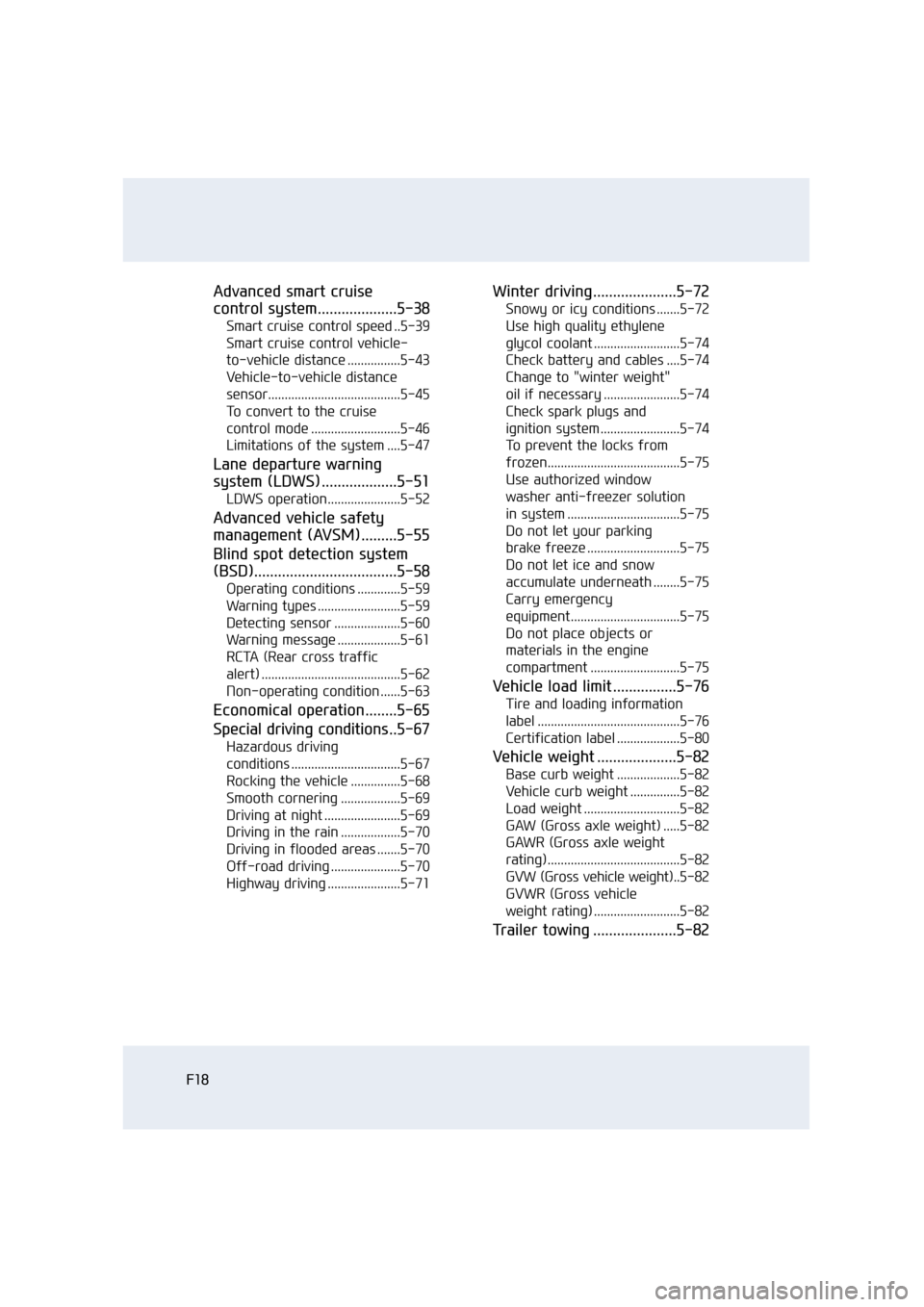
F18
Advanced smart cruise
control system....................5-38
Smart cruise control speed ..5-39
Smart cruise control vehicle-
to-vehicle distance ................5-43
Vehicle-to-vehicle distance
sensor........................................5-45
To convert to the cruise
control mode ...........................5-46
Limitations of the system ....5-47
Lane departure warning
system (LDWS) ...................5-51
LDWS operation......................5-52
Advanced vehicle safety
management (AVSM).........5-55
Blind spot detection system
(BSD)....................................5-58
Operating conditions .............5-59
Warning types .........................5-59
Detecting sensor ....................5-60
Warning message ...................5-61
RCTA (Rear cross traffic
alert) ..........................................5-62
Non-operating condition ......5-63
Economical operation........5-65
Special driving conditions.. 5-67
Hazardous driving
conditions .................................5-67
Rocking the vehicle ...............5-68
Smooth cornering ..................5-69
Driving at night .......................5-69
Driving in the rain ..................5-70
Driving in flooded areas .......5-70
Off-road driving .....................5-70
Highway driving ......................5-71
Winter driving.....................5-72
Snowy or icy conditions .......5-72
Use high quality ethylene
glycol coolant ..........................5-74
Check battery and cables ....5-74
Change to "winter weight"
oil if necessary .......................5-74
Check spark plugs and
ignition system ........................5-74
To prevent the locks from
frozen........................................5-75
Use authorized window
washer anti-freezer solution
in system ..................................5-75
Do not let your parking
brake freeze ............................5-75
Do not let ice and snow
accumulate underneath ........5-75
Carry emergency
equipment.................................5-75
Do not place objects or
materials in the engine
compartment ...........................5-75
Vehicle load limit ................5-76
Tire and loading information
label ...........................................5-76
Certification label ...................5-80
Vehicle weight ....................5-82
Base curb weight ...................5-82
Vehicle curb weight ...............5-82
Load weight .............................5-82
GAW (Gross axle weight) .....5-82
GAWR (Gross axle weight
rating) ........................................5-82
GVW (Gross vehicle weight).. 5-82
GVWR (Gross vehicle
weight rating) ..........................5-82
Trailer towing .....................5-82
Page 19 of 477
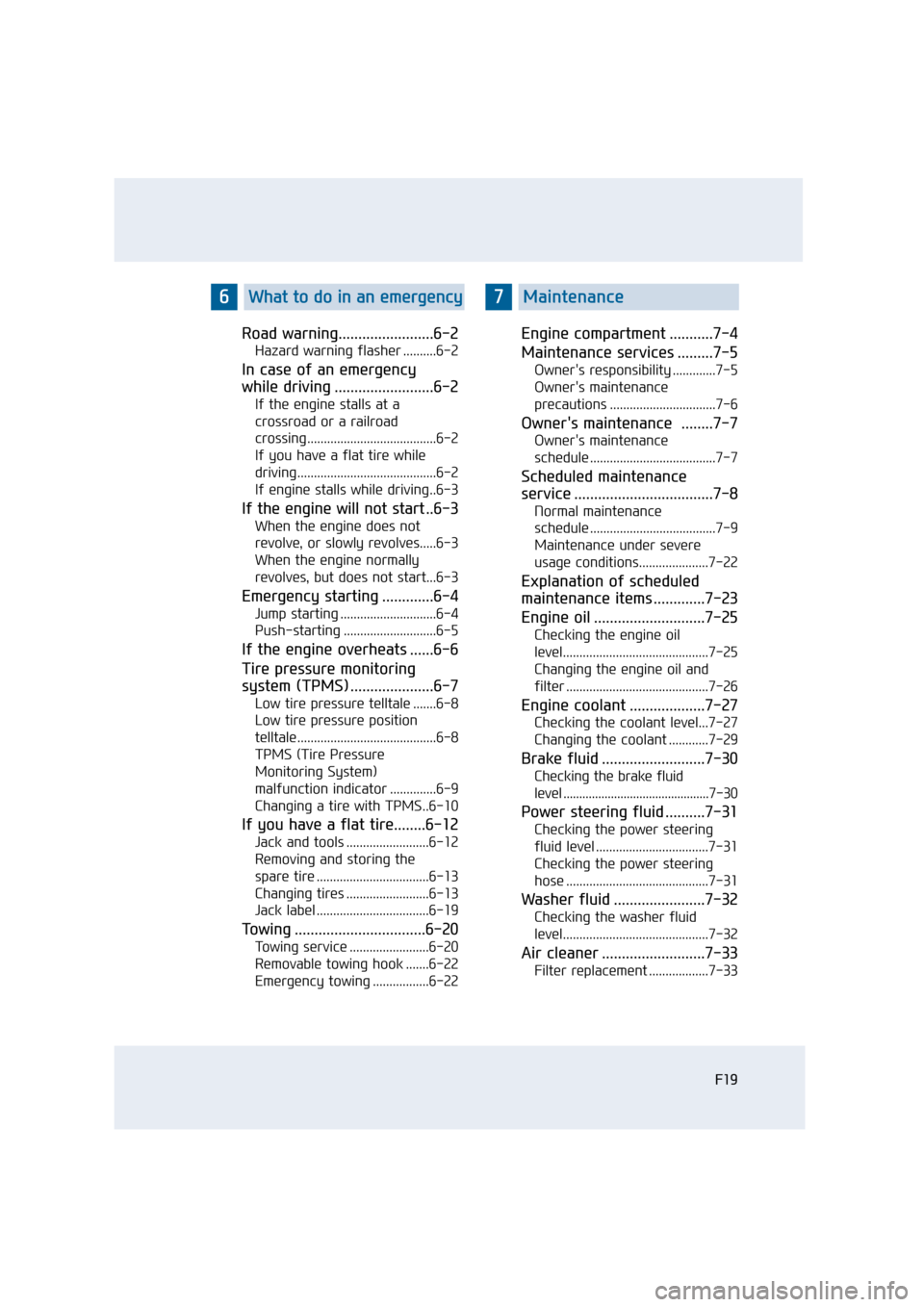
Road warning........................6-2
Hazard warning flasher ..........6-2
In case of an emergency
while driving .........................6-2
If the engine stalls at a
crossroad or a railroad
crossing.......................................6-2
If you have a flat tire while
driving..........................................6-2
If engine stalls while driving..6-3
If the engine will not start ..6-3
When the engine does not
revolve, or slowly revolves.....6-3
When the engine normally
revolves, but does not start...6-3
Emergency starting .............6-4
Jump starting .............................6-4
Push-starting ............................6-5
If the engine overheats ......6-6
Tire pressure monitoring
system (TPMS) .....................6-7
Low tire pressure telltale .......6-8
Low tire pressure position
telltale..........................................6-8
TPMS (Tire Pressure
Monitoring System)
malfunction indicator ..............6-9
Changing a tire with TPMS..6-10
If you have a flat tire........6-12
Jack and tools .........................6-12
Removing and storing the
spare tire ..................................6-13
Changing tires .........................6-13
Jack label ..................................6-19
Towing .................................6-20
Towing service ........................6-20
Removable towing hook .......6-22
Emergency towing .................6-22
Engine compartment ...........7-4
Maintenance services .........7-5
Owner's responsibility .............7-5
Owner's maintenance
precautions ................................7-6
Owner's maintenance ........7-7
Owner's maintenance
schedule ......................................7-7
Scheduled maintenance
service ...................................7-8
Normal maintenance
schedule ......................................7-9
Maintenance under severe
usage conditions.....................7-22
Explanation of scheduled
maintenance items .............7-23
Engine oil ............................7-25
Checking the engine oil
level............................................7-25
Changing the engine oil and
filter ...........................................7-26
Engine coolant ...................7-27
Checking the coolant level...7-27
Changing the coolant ............7-29
Brake fluid ..........................7-30
Checking the brake fluid
level ..............................................7-30
Power steering fluid ..........7-31
Checking the power steering
fluid level ..................................7-31
Checking the power steering
hose ...........................................7-31
Washer fluid .......................7-32
Checking the washer fluid
level............................................7-32
Air cleaner ..........................7-33
Filter replacement ..................7-33
F19
6What to do in an emergency7Maintenance
Page 187 of 477
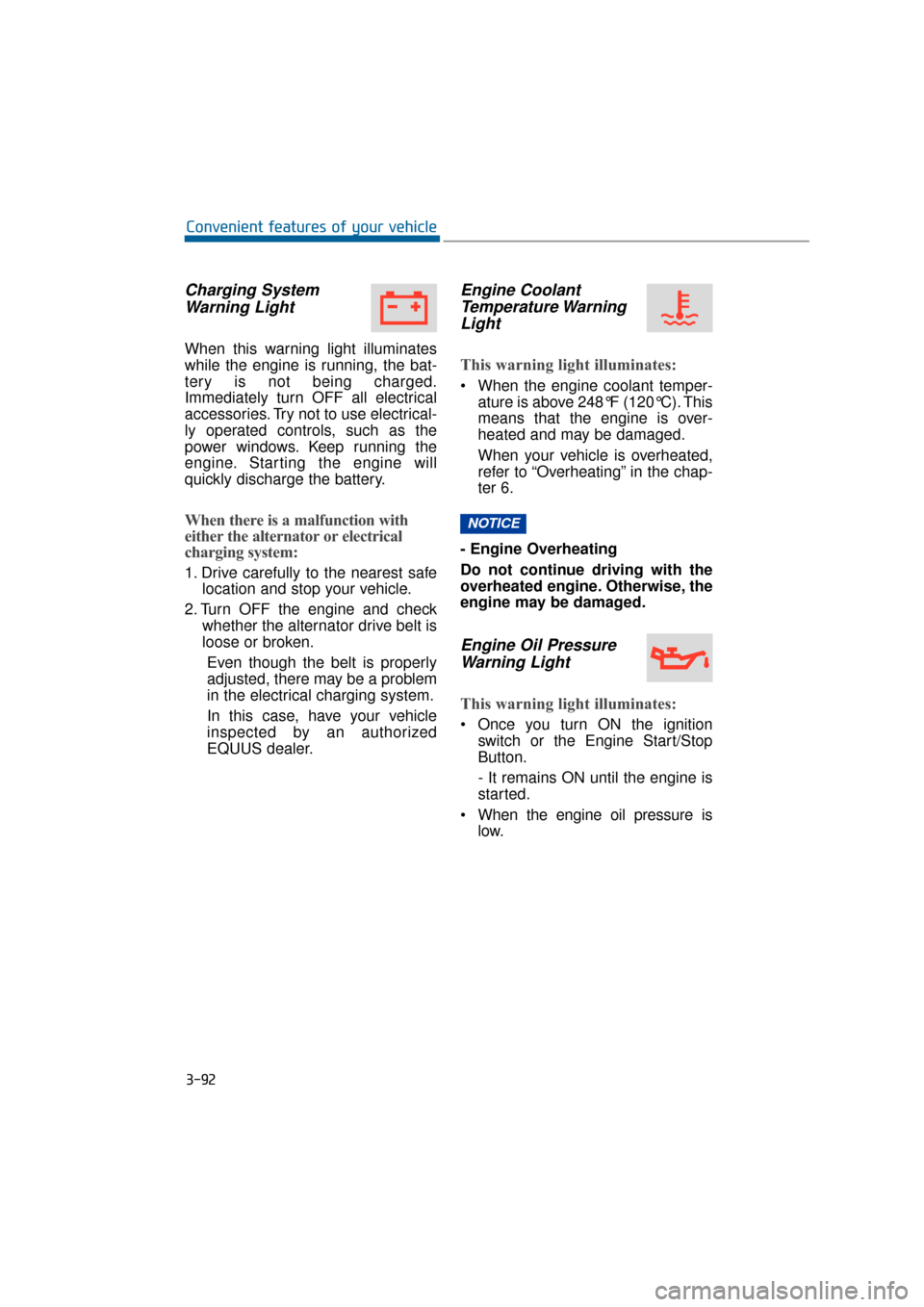
Charging SystemWarning Light
When this warning light illuminates
while the engine is running, the bat-
tery is not being charged.
Immediately turn OFF all electrical
accessories. Try not to use electrical-
ly operated controls, such as the
power windows. Keep running the
engine. Starting the engine will
quickly discharge the battery.
When there is a malfunction with
either the alternator or electrical
charging system:
1. Drive carefully to the nearest safe location and stop your vehicle.
2. Turn OFF the engine and check whether the alternator drive belt is
loose or broken.
Even though the belt is properly
adjusted, there may be a problem
in the electrical charging system.
In this case, have your vehicle
inspected by an authorized
EQUUS dealer.
Engine CoolantTemperature WarningLight
This warning light illuminates:
When the engine coolant temper-
ature is above 248°F (120°C). This
means that the engine is over-
heated and may be damaged.
When your vehicle is overheated,
refer to “Overheating” in the chap-
ter 6.
- Engine Overheating
Do not continue driving with the
overheated engine. Otherwise, the
engine may be damaged.
Engine Oil Pressure Warning Light
This warning light illuminates:
Once you turn ON the ignition
switch or the Engine Start/Stop
Button.
- It remains ON until the engine is
started.
When the engine oil pressure is low.
NOTICE
3-92
Convenient features of your vehicle
Page 188 of 477
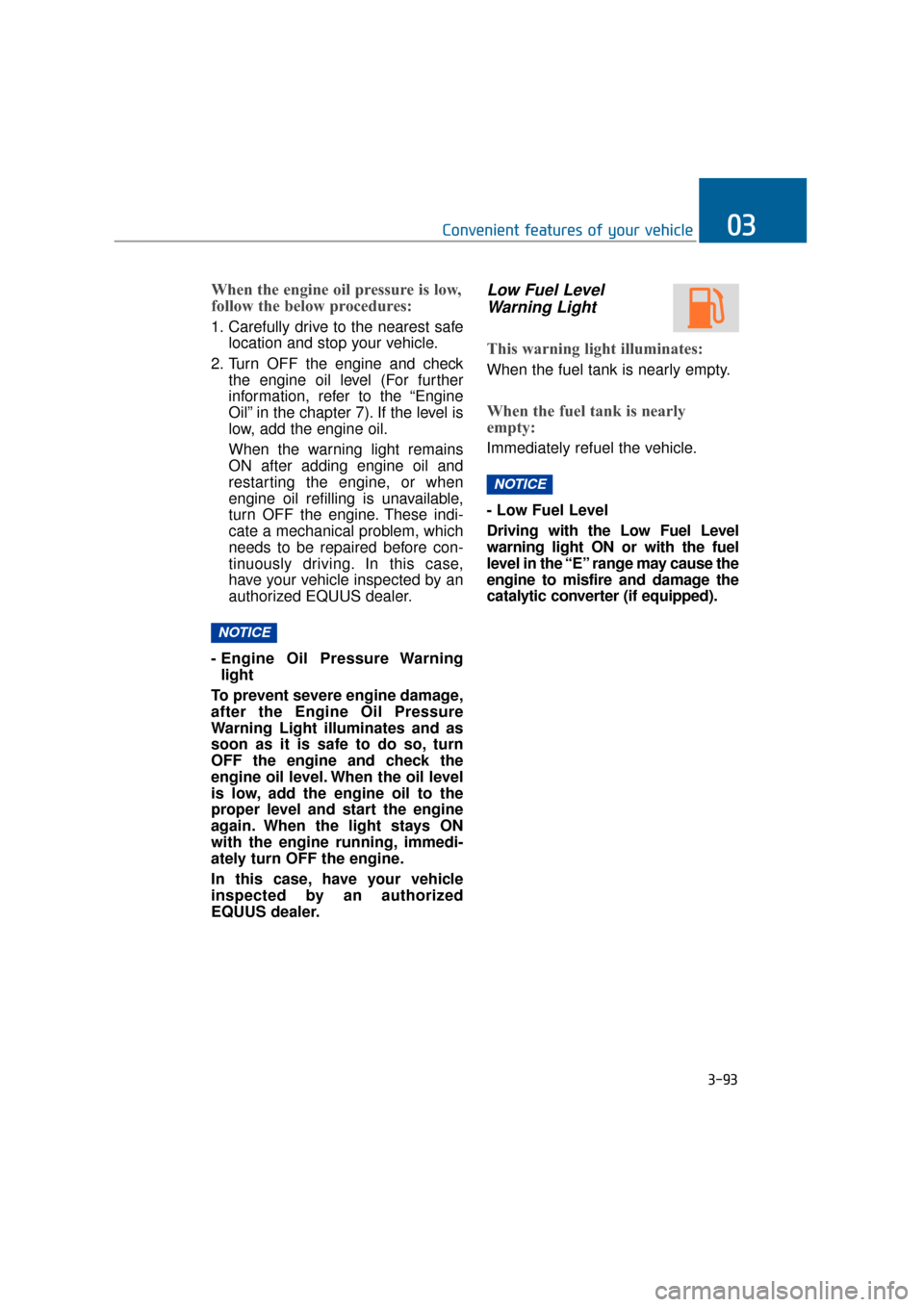
When the engine oil pressure is low,
follow the below procedures:
1. Carefully drive to the nearest safelocation and stop your vehicle.
2. Turn OFF the engine and check the engine oil level (For further
information, refer to the “Engine
Oil” in the chapter 7). If the level is
low, add the engine oil.
When the warning light remains
ON after adding engine oil and
restarting the engine, or when
engine oil refilling is unavailable,
turn OFF the engine. These indi-
cate a mechanical problem, which
needs to be repaired before con-
tinuously driving. In this case,
have your vehicle inspected by an
authorized EQUUS dealer.
- Engine Oil Pressure Warning light
To prevent severe engine damage,
after the Engine Oil Pressure
Warning Light illuminates and as
soon as it is safe to do so, turn
OFF the engine and check the
engine oil level. When the oil level
is low, add the engine oil to the
proper level and start the engine
again. When the light stays ON
with the engine running, immedi-
ately turn OFF the engine.
In this case, have your vehicle
inspected by an authorized
EQUUS dealer.
Low Fuel Level Warning Light
This warning light illuminates:
When the fuel tank is nearly empty.
When the fuel tank is nearly
empty:
Immediately refuel the vehicle.
- Low Fuel Level
Driving with the Low Fuel Level
warning light ON or with the fuel
level in the “E” range may cause the
engine to misfire and damage the
catalytic converter (if equipped).
NOTICE
NOTICE
3-93
Convenient features of your vehicle03
Page 232 of 477
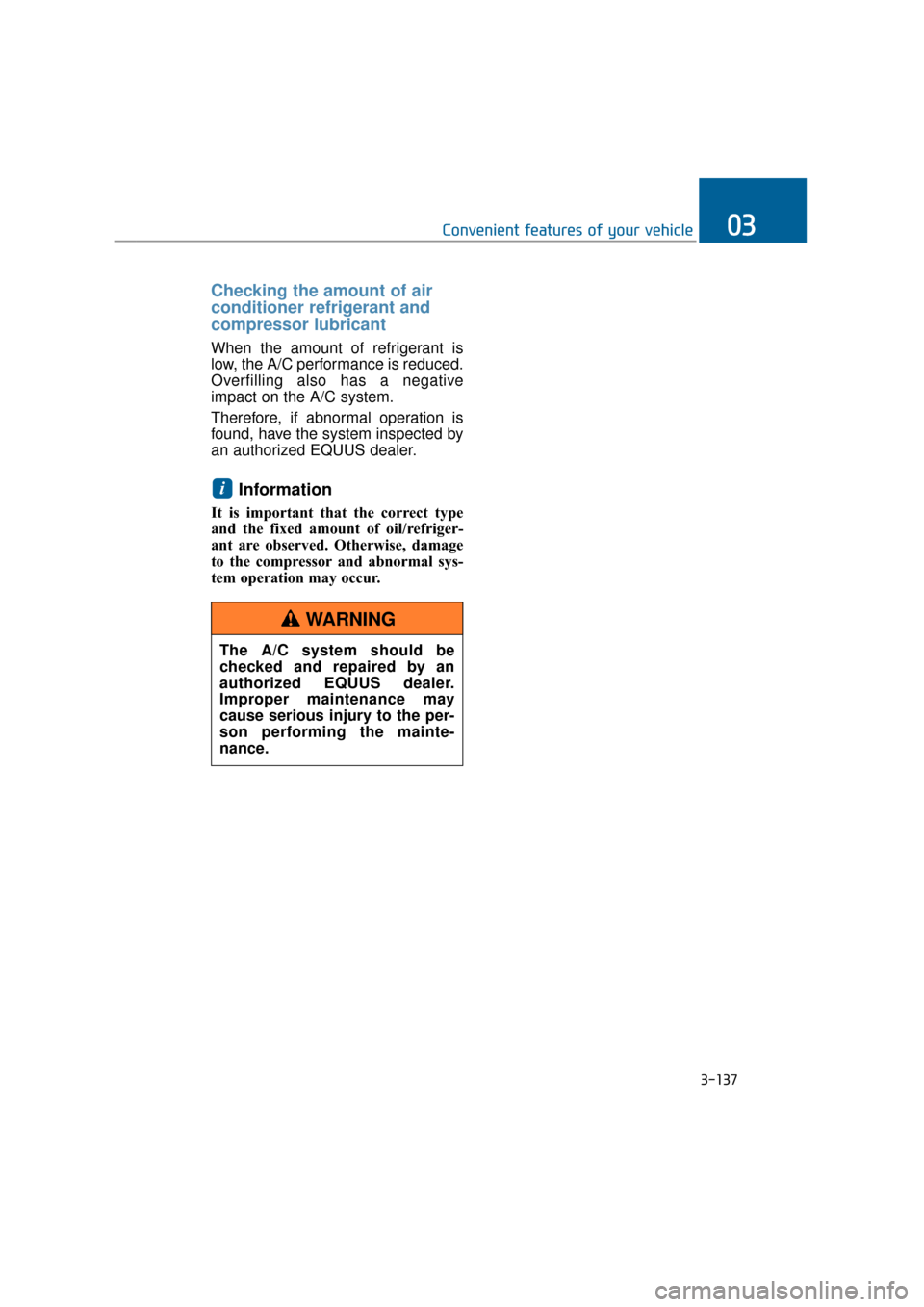
3-137
Convenient features of your vehicle03
Checking the amount of air
conditioner refrigerant and
compressor lubricant
When the amount of refrigerant is
low, the A/C performance is reduced.
Overfilling also has a negative
impact on the A/C system.
Therefore, if abnormal operation is
found, have the system inspected by
an authorized EQUUS dealer.
Information
It is important that the correct type
and the fixed amount of oil/refriger-
ant are observed. Otherwise, damage
to the compressor and abnormal sys-
tem operation may occur.
i
The A/C system should be
checked and repaired by an
authorized EQUUS dealer.
Improper maintenance may
cause serious injury to the per-
son performing the mainte-
nance.
WARNING
Page 254 of 477
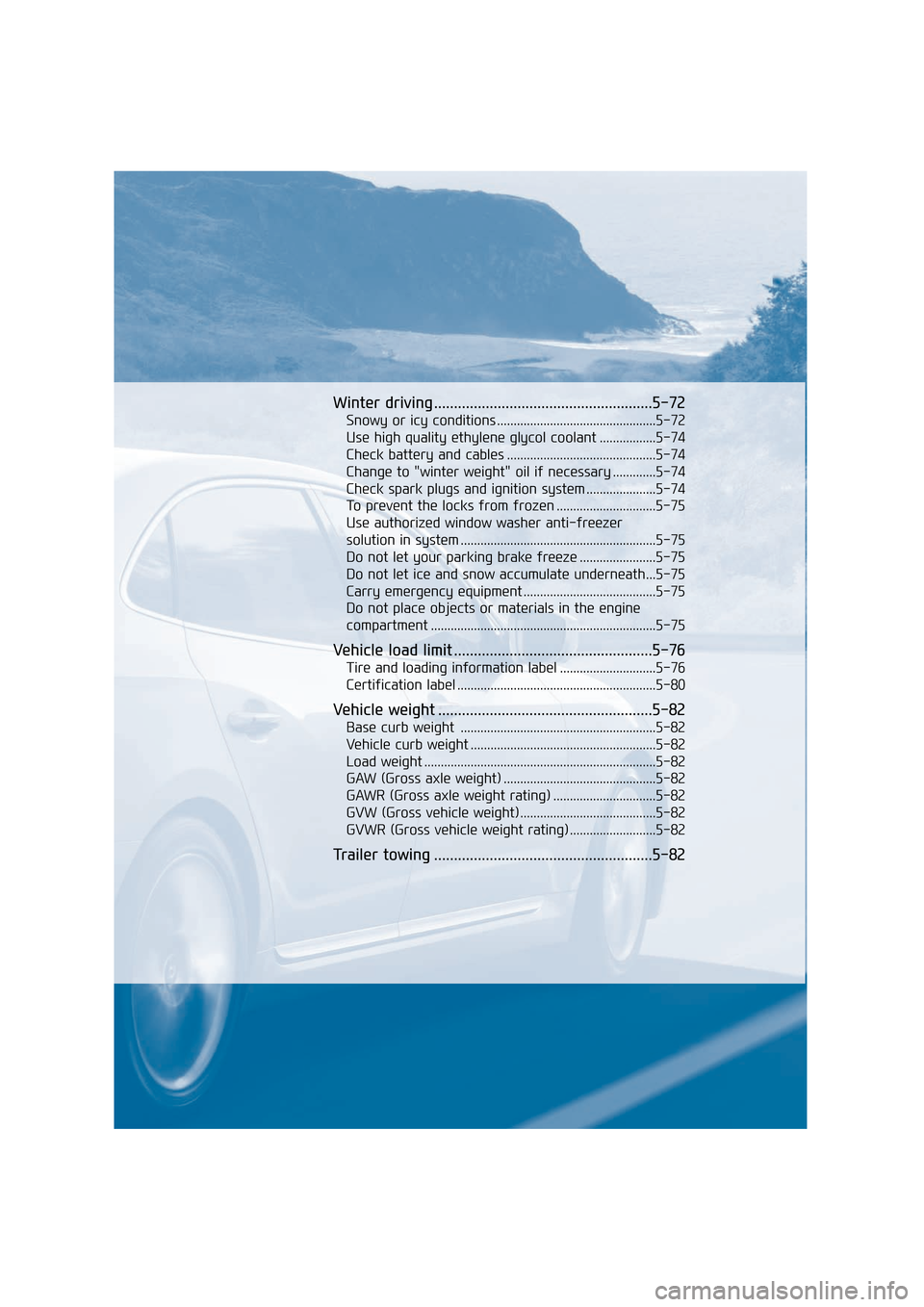
Winter driving .......................................................5-72
Snowy or icy conditions ................................................5-72
Use high quality ethylene glycol coolant .................5-74
Check battery and cables .............................................5-74
Change to "winter weight" oil if necessary .............5-74
Check spark plugs and ignition system .....................5-74
To prevent the locks from frozen ..............................5-75
Use authorized window washer anti-freezer
solution in system ...........................................................5-75
Do not let your parking brake freeze .......................5-75
Do not let ice and snow accumulate underneath...5-75
Carry emergency equipment ........................................5-75
Do not place objects or materials in the engine
compartment ....................................................................5-75\
Vehicle load limit ..................................................5-76
Tire and loading information label .............................5-76
Certification label ............................................................5-80
Vehicle weight ......................................................5-82
Base curb weight ...........................................................5-82
Vehicle curb weight ........................................................5-82
Load weight ......................................................................5-\
82
GAW (Gross axle weight) ..............................................5-82
GAWR (Gross axle weight rating) ...............................5-82
GVW (Gross vehicle weight) .........................................5-82
GVWR (Gross vehicle weight rating) ..........................5-82
Trailer towing .......................................................5-82
Page 255 of 477
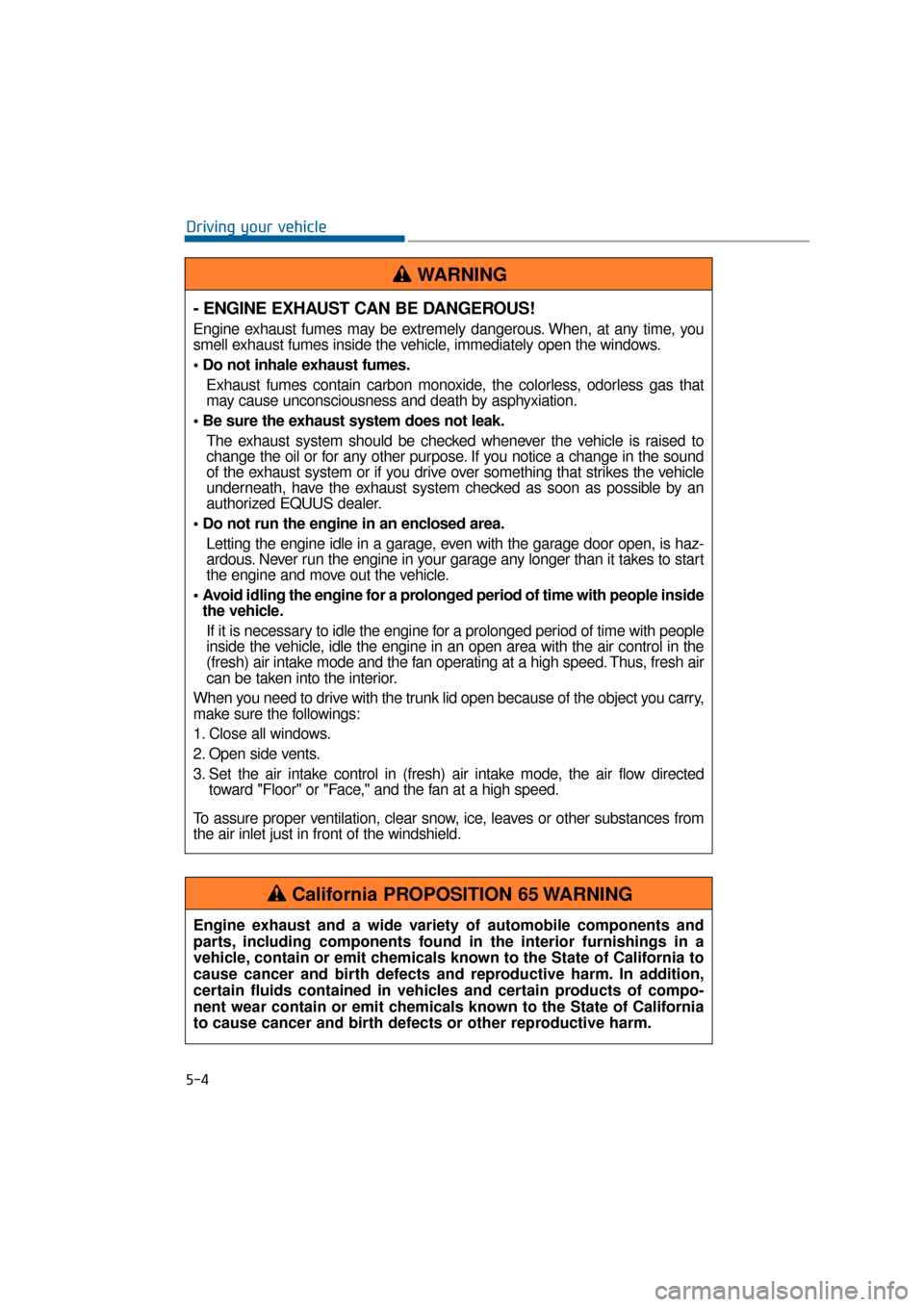
5-4
Driving your vehicle
- ENGINE EXHAUST CAN BE DANGEROUS!
Engine exhaust fumes may be extremely dangerous. When, at any time, you
smell exhaust fumes inside the vehicle, immediately open the windows.
• Do not inhale exhaust fumes.Exhaust fumes contain carbon monoxide, the colorless, odorless gas that
may cause unconsciousness and death by asphyxiation.
The exhaust system should be checked whenever the vehicle is raised to
change the oil or for any other purpose. If you notice a change in the sound
of the exhaust system or if you drive over something that strikes the vehicle
underneath, have the exhaust system checked as soon as possible by an
authorized EQUUS dealer.
Letting the engine idle in a garage, even with the garage door open, is haz-
ardous. Never run the engine in your garage any longer than it takes to start
the engine and move out the vehicle.
Avoid idling the engine for a prolonged period of time with people inside the vehicle.
If it is necessary to idle the engine for a prolonged period of time with people
inside the vehicle, idle the engine in an open area with the air control in the
(fresh) air intake mode and the fan operating at a high speed. Thus, fresh air
can be taken into the interior.
When you need to drive with the trunk lid open because of the object you carry,
make sure the followings:
1. Close all windows.
2. Open side vents.
3. Set the air intake control in (fresh) air intake mode, the air flow directed toward "Floor" or "Face," and the fan at a high speed.
To assure proper ventilation, clear snow, ice, leaves or other substances from
the air inlet just in front of the windshield.
WARNING
Engine exhaust and a wide variety of automobile components and
parts, including components found in the interior furnishings in a
vehicle, contain or emit chemicals known to the State of California to
cause cancer and birth defects and reproductive harm. In addition,
certain fluids contained in vehicles and certain products of compo-
nent wear contain or emit chemicals known to the State of California
to cause cancer and birth defects or other reproductive harm.
California PROPOSITION 65 WARNING
Page 256 of 477
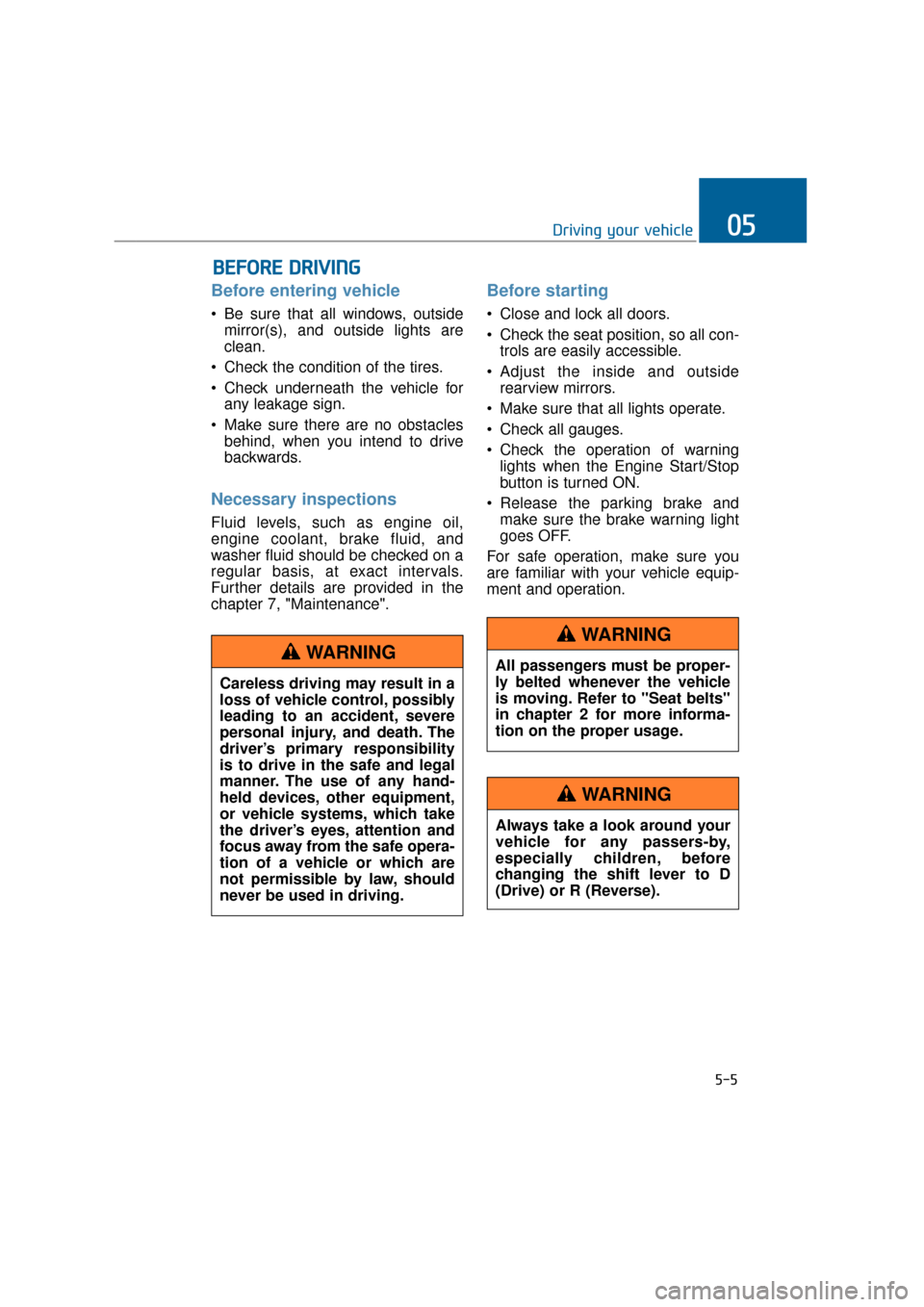
Before entering vehicle
• Be sure that all windows, outsidemirror(s), and outside lights are
clean.
Check the condition of the tires.
Check underneath the vehicle for any leakage sign.
Make sure there are no obstacles behind, when you intend to drive
backwards.
Necessary inspections
Fluid levels, such as engine oil,
engine coolant, brake fluid, and
washer fluid should be checked on a
regular basis, at exact intervals.
Further details are provided in the
chapter 7, "Maintenance".
Before starting
Close and lock all doors.
Check the seat position, so all con-trols are easily accessible.
Adjust the inside and outside rearview mirrors.
Make sure that all lights operate.
Check all gauges.
Check the operation of warning lights when the Engine Start/Stop
button is turned ON.
Release the parking brake and make sure the brake warning light
goes OFF.
For safe operation, make sure you
are familiar with your vehicle equip-
ment and operation.
B B E
EF
FO
O R
RE
E
D
D R
RI
IV
V I
IN
N G
G
5-5
Driving your vehicle05
Careless driving may result in a
loss of vehicle control, possibly
leading to an accident, severe
personal injury, and death. The
driver’s primary responsibility
is to drive in the safe and legal
manner. The use of any hand-
held devices, other equipment,
or vehicle systems, which take
the driver’s eyes, attention and
focus away from the safe opera-
tion of a vehicle or which are
not permissible by law, should
never be used in driving.
WARNINGAll passengers must be proper-
ly belted whenever the vehicle
is moving. Refer to "Seat belts"
in chapter 2 for more informa-
tion on the proper usage.
WARNING
Always take a look around your
vehicle for any passers-by,
especially children, before
changing the shift lever to D
(Drive) or R (Reverse).
WARNING
Page 322 of 477
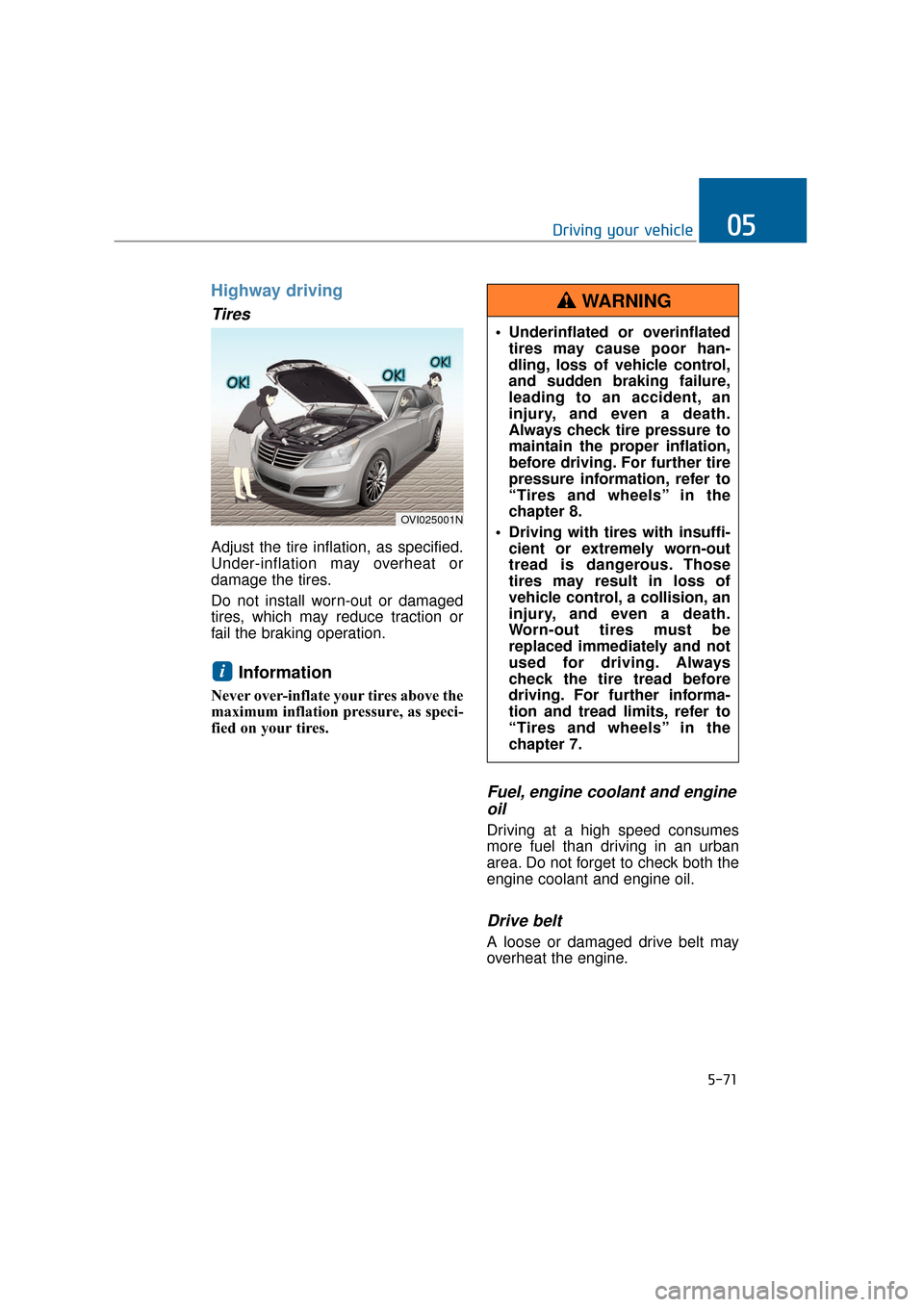
5-71
Driving your vehicle05
Highway driving
Tires
Adjust the tire inflation, as specified.
Under-inflation may overheat or
damage the tires.
Do not install worn-out or damaged
tires, which may reduce traction or
fail the braking operation.
Information
Never over-inflate your tires above the
maximum inflation pressure, as speci-
fied on your tires.
Fuel, engine coolant and engineoil
Driving at a high speed consumes
more fuel than driving in an urban
area. Do not forget to check both the
engine coolant and engine oil.
Drive belt
A loose or damaged drive belt may
overheat the engine.
i
OVI025001N
Underinflated or overinflated
tires may cause poor han-
dling, loss of vehicle control,
and sudden braking failure,
leading to an accident, an
injury, and even a death.
Always check tire pressure to
maintain the proper inflation,
before driving. For further tire
pressure information, refer to
“Tires and wheels” in the
chapter 8.
Driving with tires with insuffi- cient or extremely worn-out
tread is dangerous. Those
tires may result in loss of
vehicle control, a collision, an
injury, and even a death.
Worn-out tires must be
replaced immediately and not
used for driving. Always
check the tire tread before
driving. For further informa-
tion and tread limits, refer to
“Tires and wheels” in the
chapter 7.
WARNING
Page 325 of 477
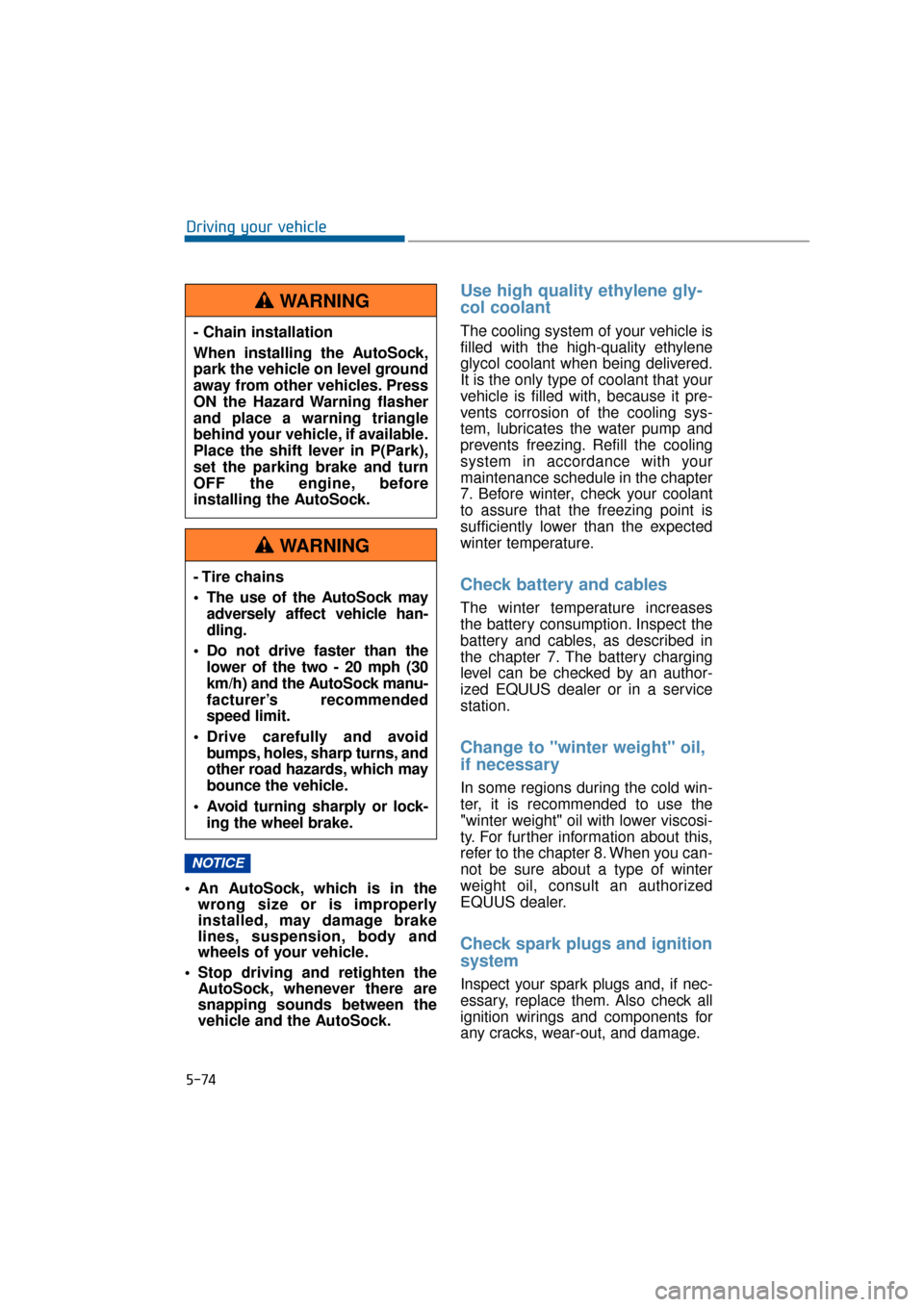
5-74
Driving your vehicle
An AutoSock, which is in the wrong size or is improperly
installed, may damage brake
lines, suspension, body and
wheels of your vehicle.
Stop driving and retighten the AutoSock, whenever there are
snapping sounds between the
vehicle and the AutoSock.
Use high quality ethylene gly-
col coolant
The cooling system of your vehicle is
filled with the high-quality ethylene
glycol coolant when being delivered.
It is the only type of coolant that your
vehicle is filled with, because it pre-
vents corrosion of the cooling sys-
tem, lubricates the water pump and
prevents freezing. Refill the cooling
system in accordance with your
maintenance schedule in the chapter
7. Before winter, check your coolant
to assure that the freezing point is
sufficiently lower than the expected
winter temperature.
Check battery and cables
The winter temperature increases
the battery consumption. Inspect the
battery and cables, as described in
the chapter 7. The battery charging
level can be checked by an author-
ized EQUUS dealer or in a service
station.
Change to "winter weight" oil,
if necessary
In some regions during the cold win-
ter, it is recommended to use the
"winter weight" oil with lower viscosi-
ty. For further information about this,
refer to the chapter 8. When you can-
not be sure about a type of winter
weight oil, consult an authorized
EQUUS dealer.
Check spark plugs and ignition
system
Inspect your spark plugs and, if nec-
essary, replace them. Also check all
ignition wirings and components for
any cracks, wear-out, and damage.
NOTICE
- Chain installation
When installing the AutoSock,
park the vehicle on level ground
away from other vehicles. Press
ON the Hazard Warning flasher
and place a warning triangle
behind your vehicle, if available.
Place the shift lever in P(Park),
set the parking brake and turn
OFF the engine, before
installing the AutoSock.
WARNING
- Tire chains
The use of the AutoSock may
adversely affect vehicle han-
dling.
Do not drive faster than the lower of the two - 20 mph (30
km/h) and the AutoSock manu-
facturer’s recommended
speed limit.
Drive carefully and avoid bumps, holes, sharp turns, and
other road hazards, which may
bounce the vehicle.
Avoid turning sharply or lock- ing the wheel brake.
WARNING